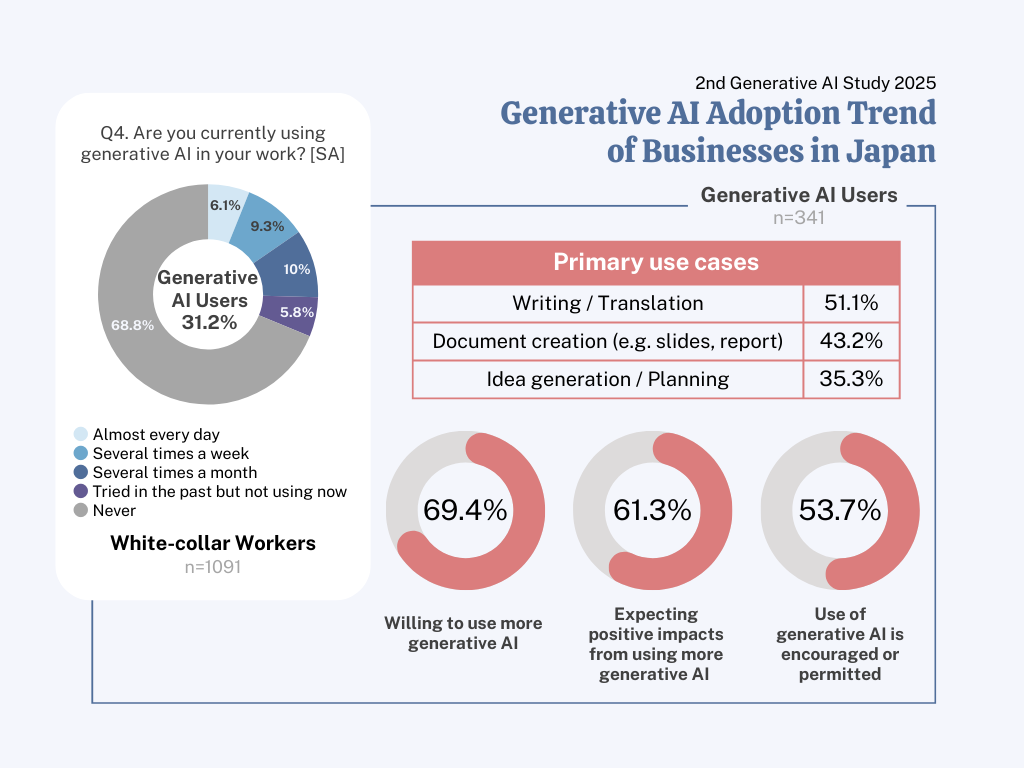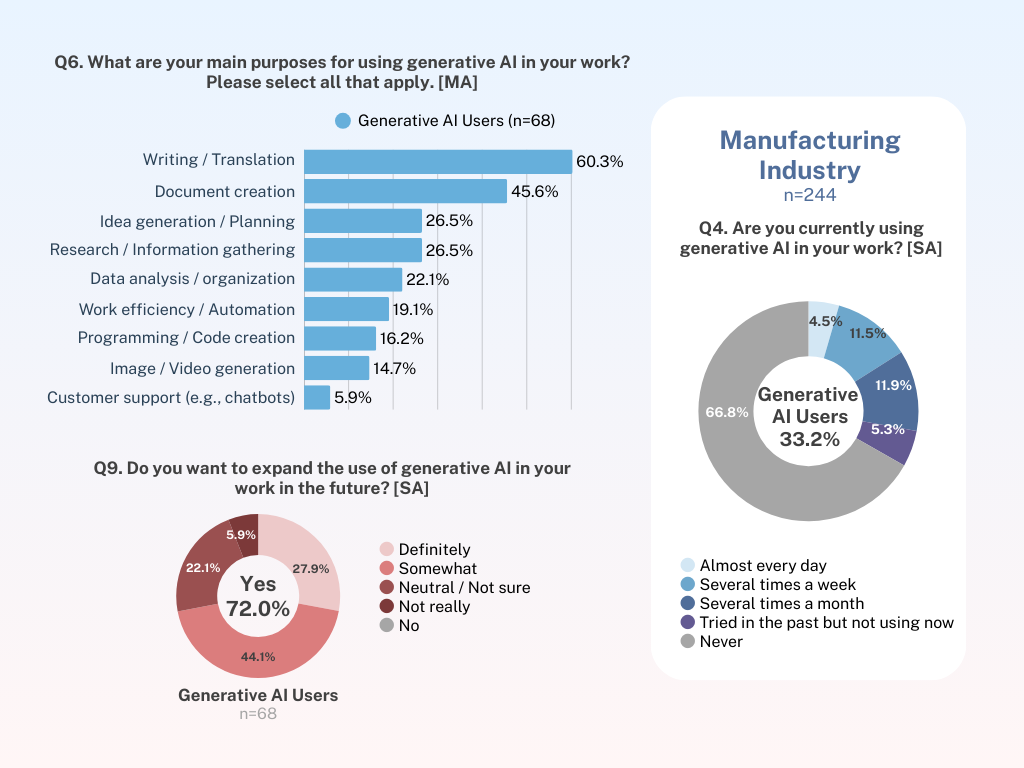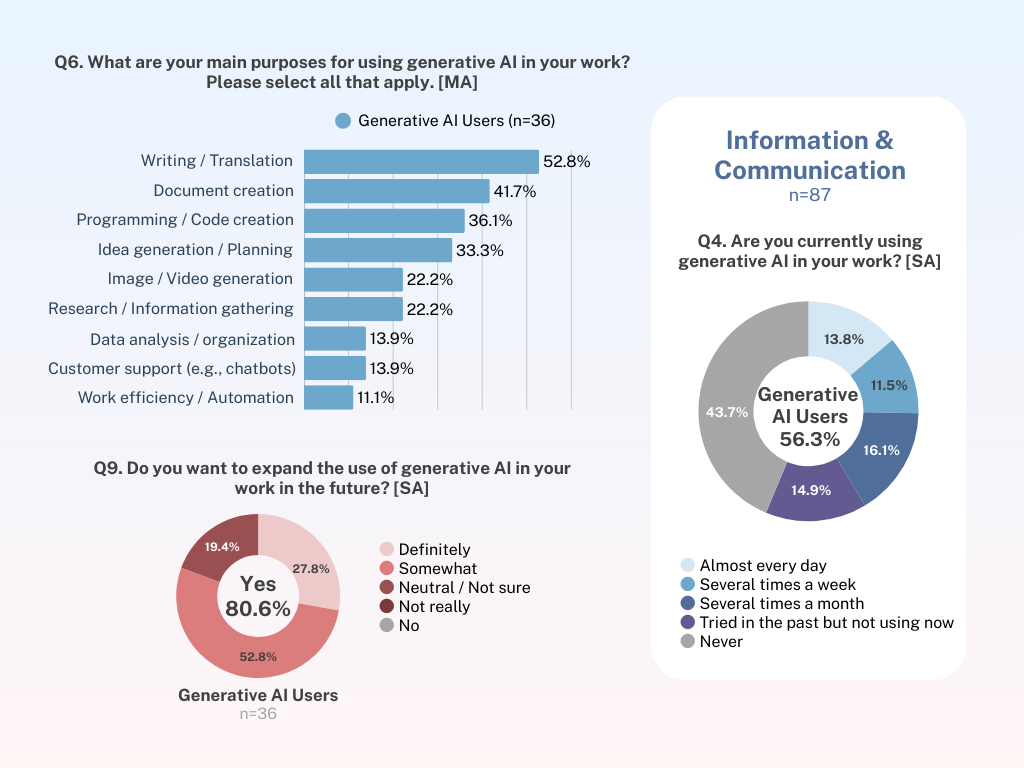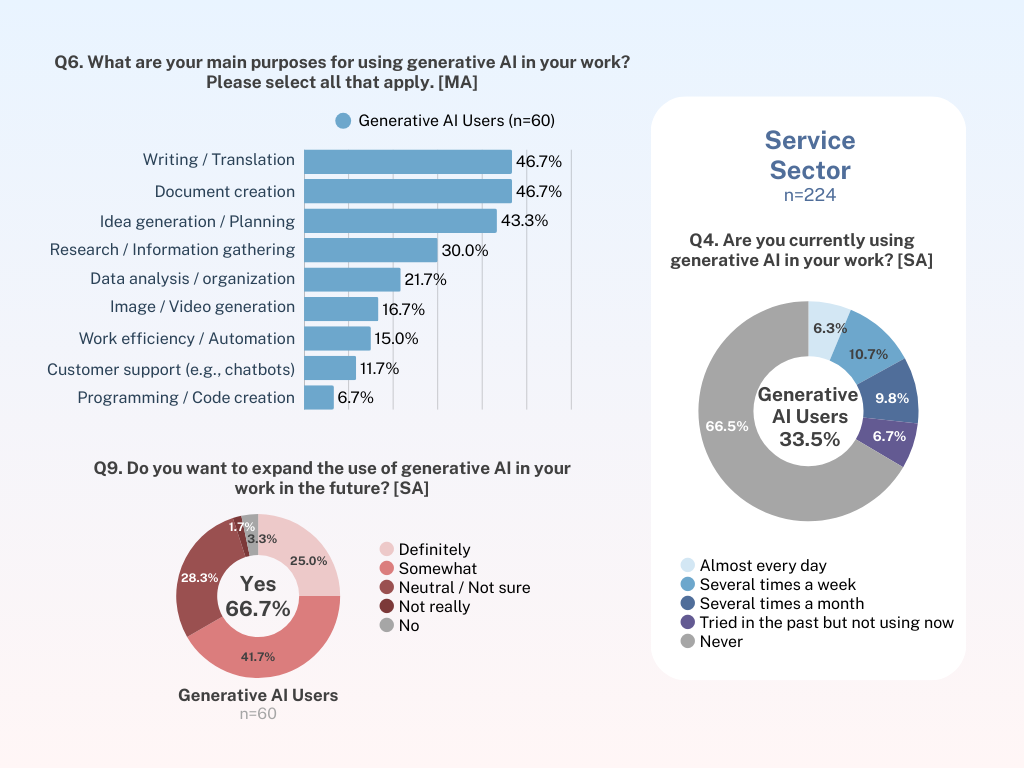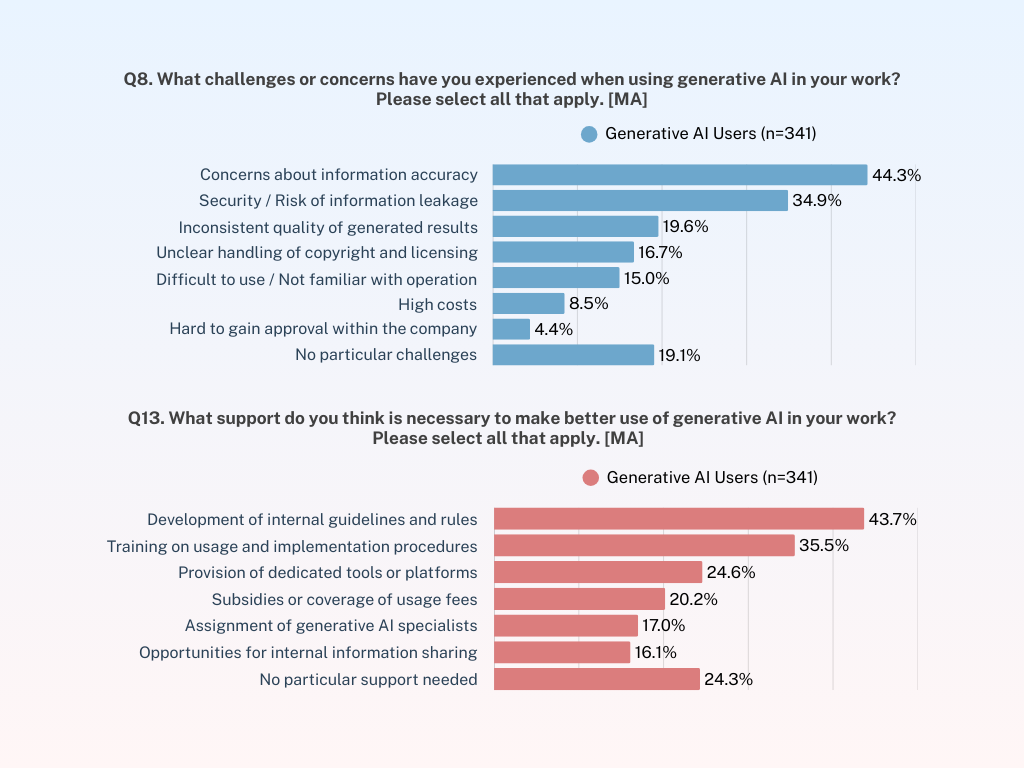Japan’s Generative AI Market: Insights and Opportunities for U.S. Tech and IT Providers
2025/09/01

Table of Contents
Introduction
Japan's corporate sector is approaching a significant inflection in generative AI adoption. Unlike the United States, where AI agents have been quickly placed into the blight of everyday workflows amongst the industries, Japanese companies are moving at a more cautious pace. This contrast does not suggest reluctance, but rather reflects Japan’s characteristic emphasis on precision, risk management, and gradual testing before scaling.
For U.S. IT solution providers, this difference represents an opportunity. While U.S. businesses may prioritize speed to market, Japanese firms are looking for partners who can deliver trust, compliance, and long-term value. In May 2025, GMO Research & AI conducted a second-wave survey on generative AI adoption in Japan. Insights from more than 1,000 Japanese professionals highlight emerging opportunities, revealing distinct adoption trends, tool preferences, and sector-specific challenges.
Three industries stand out: Manufacturing, Information & Communication, and Service Industries. Together, they represent both the largest respondent groups and the areas where U.S. vendors can most effectively align their solutions with local needs.
Survey Specifications
-
Survey Date: May 22, 2025
Method: Online survey
Target Group: White-collar workers aged 20-69
Region: Japan
Sample Size: 1,091
Conducted by: GMO Research & AI
▶▶Explore our first-wave survey report, including insights on the daily use of generative AI in Japan!
Key Takeaways from the Survey
Across industries, adoption of generative AI is steady but growing — and the data reveals clear signals of future expansion:
- ・31.2% of the respondents are using or have used generative AI in work.
- ・69.4% of generative AI users expressed intent to expand their use, with 27% saying they want to adopt proactively and 42% somewhat positive about wider adoption.
- ・Primary use cases: support for writing and translation (51.5%), document creation such as reports and slides (43.2%), idea generation and planning (35.3%), research and information gathering (25.5%).
- ・Corporate policies: about 26% of companies actively encourage AI use, 28% allow it under certain conditions, and 3% of companies restrict its use or prohibit it outright. The fact that more than 40% respond that there is no clear company-wide policy suggests significant room for structured governance.
- ・61.3% of users reported that they believe generative AI has a positive impact on their tasks.
These findings indicate that generative AI use is still developing in Japan and organizational frameworks are only just beginning to take shape. For U.S. solution providers, this underscores the dual opportunity to support practical adoption and guide policy development.
Industry Spotlight: Manufacturing
Adoption Rate & Use Cases
In manufacturing (n=244), 33.2% of respondents reported using generative AI at least occasionally or have used it before. Among this group of AI users (n=81), daily usage is still limited (13.6%), but 34.6% use AI several times per week and 35.8% several times monthly, showing gradual integration into workflows.
The most common applications are document and slide preparation (45.6%), ideation for design and product planning (26.5%), and notably, translation and drafting support (60.3%) — one of the highest rates among all industries.
Expansion Intentions
About 72% of manufacturing professionals want to expand adoption — 27.9% proactively and 44.1% moderately — suggesting strong latent demand once integration challenges are addressed.
Opportunity for U.S. Providers
Solutions that emphasize secure integration with industrial platforms, combined with Japanese-language support for technical documents, will resonate strongly. For U.S. providers, offering compliance-ready, efficiency-enhancing AI tools can secure partnerships with Japan’s global leaders in automotive, electronics, and machinery.
Industry Spotlight: Information & Communication
Adoption Rate & Use Cases
The information and communication sector (n=87) is the most advanced adopter. Among participants using or have used AI (56.3%), 24.5% use it every day, 20.4% use it several times throughout the week, and 28.6% use it monthly. Frequent and widespread uses include document creation (41.7%), ideation (33.3%), and translation and text generation (52.8%). Code generation and customer chatbot deployment may also be growing in their space, reflecting their technical focus.
Corporate Readiness & Expansion Intentions
This sector shows the strongest organizational readiness: 38.8% of companies actively encourage AI use, and another 20.4% allow it under guidelines. Data show formal training programs are more common here than in other industries.
More than 80% want to expand adoption, including 27.8% proactively and 52.8% moderately — the most aggressive expansion stance across all industries.
Opportunity for U.S. Providers
For U.S. vendors, this sector represents the fastest path to market entry. Secure API-friendly solutions that integrate with Japanese telecom and IT infrastructure — especially those optimized for Japanese NLP — will find immediate demand. With Japan advancing 5G and cloud transformation, AI will play a central role in competitiveness.
Industry Spotlight: Service Sector
Adoption Rate & Use Cases
In the broader service sector (n=224), 33.5% have adopted generative AI in their work. Adoption is moderate and shows growth potential, with 18.7% using it daily. Utilization focuses on document creation (46.7%), idea generation (43.3%), and translation/writing support (46.7%). For consulting, hospitality, and creative businesses, these applications are directly tied to customer-facing work.
Expansion Intentions
Still, enthusiasm is evident: about two-thirds of respondents want to expand adoption — 25% proactively and 41.7% moderately. This signals substantial untapped growth once tools become more accessible. The push for expansion may be driven by labor shortages, particularly in hospitality and tourism, where AI is seen as a way to compensate for staffing gaps.
Opportunity for U.S. Providers
The service industry represents a high-potential, underpenetrated market. U.S. providers that deliver affordable, intuitive SaaS solutions with localized templates, step-by-step onboarding, and tiered subscription models can capture this segment quickly. The rebound of inbound tourism and growing reliance on digital marketing create additional momentum.
Cross-Industry Insights & Opportunities for U.S. IT Providers
The following cross-industry insights highlight both the challenges that limit generative AI adoption and the types of support needed to expand its use. Together, these findings reveal the main barriers to adoption as well as opportunities for vendors to differentiate their offerings.
-
1. Security and Accuracy as Differentiators
With 44.3% citing accuracy concerns and 34.9% worried about security, solutions that emphasize auditability and compliance will win trust.
-
2. High Demand for Training
To further expand use of generative AI, 35.5% of respondents called for more structured training and onboarding. Bundled education programs can accelerate adoption and differentiate offerings.
-
3. Integration with Local Platforms
Compatibility with ERP, CRM, and popular communication tools in Japan like LINE and Microsoft Teams is critical for wide-scale adoption.
-
4. Cultural Nuance in UX
Japanese business culture values politeness, precision, and structured outputs. Vendors that reflect these traits in their interfaces — such as polite defaults and predictable formats — can ease adoption and reduce friction.
Conclusion: The Time to Act Is Now
Japan’s generative AI market is no longer theoretical. 31.2% of professionals already use AI in their workflows, and nearly half want to expand their use of AI. While adoption rates differ by industry, the overall momentum is unmistakable.
For U.S. providers to become successful, they must specialize in providing secure, localized solutions integrated into the peculiarities of Japan's unique business culture. Blending technical excellence with cultural transformation will let the American vendors rise above the transactional level toward the strategic enablement of Japan's digital transformation.
The window is open: companies that act now — with solutions grounded in trust and designed for local realities — can secure a lasting role in one of the world’s most influential economies. GMO Research & AI will continue to monitor the latest generative AI adoption trend in Japan and remain committed to providing up-to-date insights.
Customize your online research in APAC

